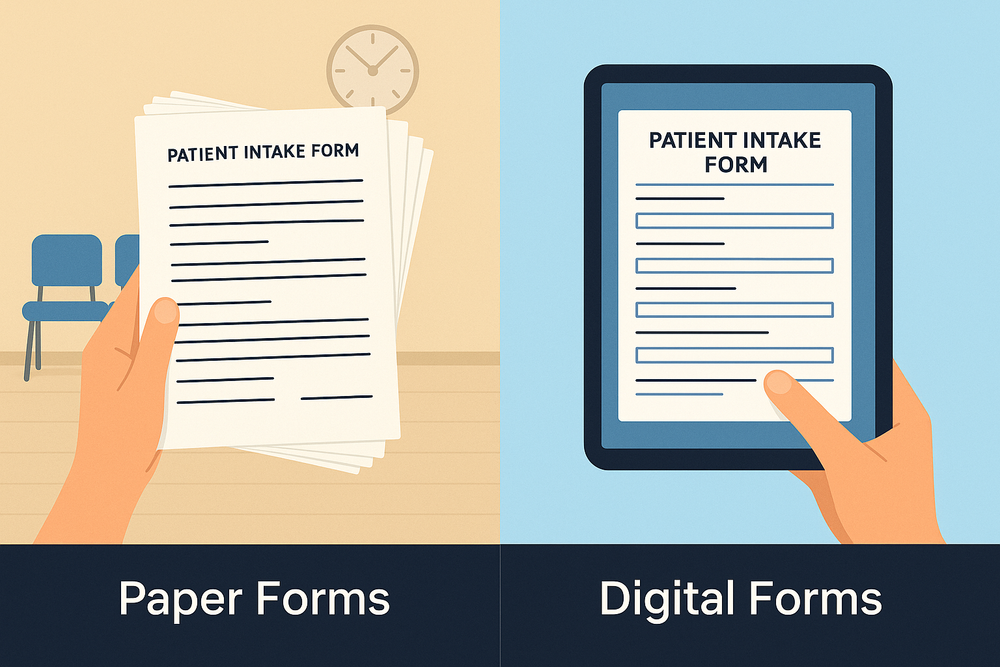A patient’s first interaction with a clinic usually isn’t with a doctor—it’s with patient intake paperwork.
Unfortunately, the intake process commonly involves long forms, crowded waiting rooms, and answering questions that are repeatedly asked in subsequent encounters. This sets the scene for a frustrating experience before the care journey has even begun.
To overcome this challenge, healthcare providers are increasingly turning to digital patient intake solutions for a more efficient and user-friendly experience. By replacing clipboards with online forms, clinics can virtually eliminate the stress and frustration involved in intake for both patients and providers.
This article begins with an overview of what patient intake is. We then explore challenges with traditional intake processes, followed by the advantages of digital intake solutions. Where appropriate, we’ll use examples of Cortico’s healthcare workflow automation solutions to provide real-world examples of online and electronic patient intake.
What Is Patient Intake?
Patient intake refers to a variety of information-gathering processes that occur in the beginning stages of the care journey. The primary purpose of patient intake is to collect pertinent details that facilitate an accurate clinical assessment and prompt delivery of care.
Typically, patient intake involves the collection of information such as:
- Personal details (name, DOB, contact info)
- Medical history (past illnesses, allergies, current medications)
- Insurance and billing information
- Consent forms
- The patient’s current symptoms or complaint
The method of collecting patient intake details depends on the practice and provider. Most commonly, patients are asked to complete a form upon presenting to a clinic or medical practice. However, patient intake can also be done before presenting to the service, either by phone or digital methods. A clinician may also continue or complete a patient intake during the first session, prior to assessment.
The Problem With Traditional Patient Intake Processes
While paper forms have been the standard for decades, they come with challenges:
Time-consuming: Patients must arrive early to complete lengthy forms, and delays in this process often result in increased waiting times.
Errors and illegibility: Handwritten data is prone to mistakes. Important information about medical history may also be unintentionally left out.
Repetition: Returning patients often have to re-enter the same information or repeat it during assessment or when seeing different providers.
Storage issues: Paper records require physical storage and are difficult to manage.
Poor patient experience: The process feels outdated and frustrating for patients, negatively impacting patient experience.
Burdening a System Already Under Strain
Traditional patient intake processes place already over-stretched clinics and physicians under further strain.
For example, administrative staff often spend much of their day helping patients navigate what should be simple intake procedures, while clinicians end up spending their valuable time filling out patient intake paperwork.
Many clinics even end up employing a dedicated patient intake coordinator or patient intake specialist, increasing overall operating costs.
Advantages of Digital Patient Intake
Electronic patient intake forms (also known as digital intake) are increasingly being used to collect information directly from patients.
Research suggests that not only is digital patient intake well accepted and usually even preferred by patients, it also tends to improve the collection of patient-reported data (PRD), which is known to enhance patient engagement.
Below is an overview of the key benefits of digital and online patient intake processes.
1. Faster Check-Ins
Patients can complete forms online from the comfort of their own homes or at a conveniently placed self-serve kiosk before their visit. This reduces waiting room congestion, allowing appointments to start on time.
Furthermore, these digital methods can integrate with EMRs to provide automated patient intake processes, where much of the intake information is already populated in the patient’s medical record before their first session.
For a real-world example of automated patient intake workflows, check out Dr. Sarah Baldwin’s webinar on how she uses Cortico in her practice.
2. Improved Accuracy
Digital forms use validation fields (e.g., required sections, dropdowns) to reduce missing or incorrect information. Data flows directly into the clinic’s system without the manual transcription errors that often occur when data is double-handled.
When patient intake management also incorporates referral information, accuracy is further enhanced. In this instance, the patient’s intake paperwork is pre-populated with details from the referral, which the clinician can then add to and adjust as required.
3. Better Patient Experience
Patients and clinicians alike get frustrated with the constant repetition that occurs throughout the care delivery process. For patients, recounting their story over and over again to different people can become tiring. For clinicians, the burden of asking for information they already know but don’t have access to represents a significant drag on efficiency.
By eliminating repetitive form-filling, electronic patient intake forms show respect for patients’ time. Families, parents, and busy clinicians especially value this convenience.
4. Secure and Compliant
Digital intake platforms are designed with security in mind, ensuring patient data is protected and compliant with HIPAA, PIPEDA, and other healthcare privacy and data security regulations.
For example, Cortico, a leading patient intake platform used by healthcare practices across the USA and Canada, is compliant with all North American Privacy regulations. We also employ digital health signatures to provide secure, tamper-proof clinical documentation.
5. Boosts Efficiency
A huge benefit of switching to online patient intake is efficiency. Clinics no longer have to deal with the logistics around storing and working with large amounts of paper-based intake forms.
Additionally, because much of the preliminary intake process is completed independently by the patient, less clinical and support time is consumed by intake tasks.
The Future of Patient Intake
Looking ahead, patient intake is likely to continue evolving in several ways.
Many of these advances are underpinned by thoughtful healthcare workflow automation, which essentially removes the repetitive administrative tasks that are essential to healthcare, but do not need to be directly completed by clinicians (or even support staff).
However, several aspects of the future of patient intake that are listed below also improve access to and quality of care.
AI-powered assistance – AI-powered patient intake systems can auto-populate relevant fields from referral information, patient responses, and details from clinicians. AI-supported patient intake can also make suggestions based on information that’s already been provided, ensuring no critical information is overlooked.
Multilingual Accessibility – Patients from culturally diverse backgrounds often have difficulty with online forms that aren’t in their native language. Digital patient intake offers comprehensive multilingual options, ensuring that all patients can complete their intake forms accurately and comfortably.
Predictive workflows – Advanced clinical analytics will enable patient intake systems to identify individuals who may require additional screening, extended (or expedited) appointment times, or specialized care protocols based on their submitted information. This predictive capability enables clinics to proactively adjust their scheduling and resource allocation, resulting in more efficient operations and improved patient outcomes.
Patient Intake: Final Thoughts
The evidence is clear: patient intake processes can already be largely automated, resulting in better outcomes for both patients and providers.
Through the use of intelligent patient engagement platforms like Cortico, what was traditionally a source of frustration and inefficiency can now become a seamless, user-friendly experience that sets a positive tone for the entire care journey.
To see how Cortico can help your practice streamline time-consuming tasks, such as patient intake, appointment reminders, and payment collection, please contact us to schedule a demo today.








